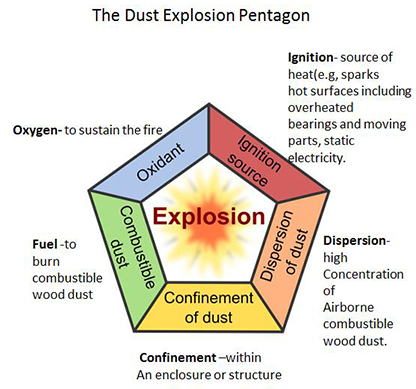

| Topic: Combustible Dust | |
| Date Issued: August 6, 2019 | Date Revised: |

The New Brunswick Occupational Health and Safety Act (OH&S Act) states that no one in a workplace can carry out work, or cause others to carry out work, if it is believed that to do so would create an undue hazard to the health and safety to any person.
Wood dust is considered an undue hazard if it creates the potential for an explosion or if it can be inhaled by the employees.
Some of the conditions that may indicate a potential for an explosion are as follows:
Remember, all fine wood dust is potentially explosive – even dust generated from ‘wet’ wood can create the conditions for an explosion.
How can the risk of explosion be recognized?
A handful of fine wood dust can be sufficient to fuel an explosion: all it takes is an eighth of an inch (1/8 in.) of accumulated dust, covering as little as five percent of the surface in a contained area.
If dust contacts a heat source there is a high risk of fire. If this happens in a contained area, it can cause an explosion. Report this hazard to your supervisor immediately.
You have the right to refuse unsafe work
If your workplace produces large quantities of wood dust, it is considered an undue hazard to allow that dust to accumulate in a contained area near a source of heat or another ignition source.
You have the right to refuse unsafe work. As an employee, you play a key role in your own safety – as well as the safety of your co-workers. That's why, under the OH&S Act, you have the right and the duty to refuse work that presents an undue hazard.
Should you see an accumulation of dust you believe could lead to a fire or explosion, you must immediately report the hazard to your supervisor or employer, and you can refuse to continue working if the situation is not resolved.
If you refuse to work under conditions that could lead to a combustible dust explosion, you're doing the right thing. Remember, you are protected from discriminatory action by putting safety first (S. 24 under the OH&S Act).
Based on materials from WorkSafeBC with permission.